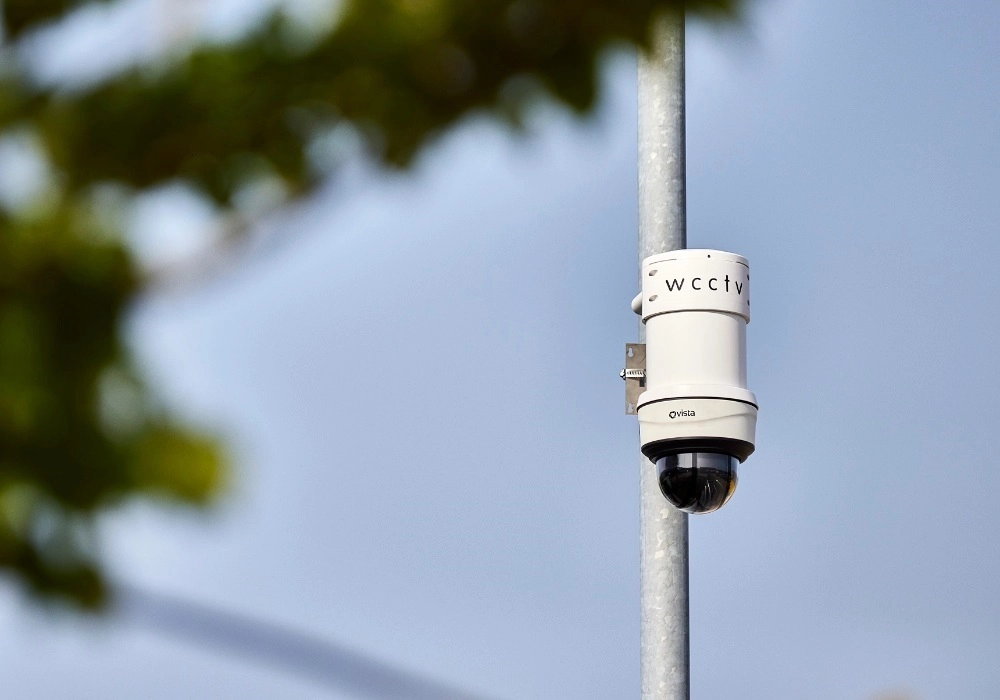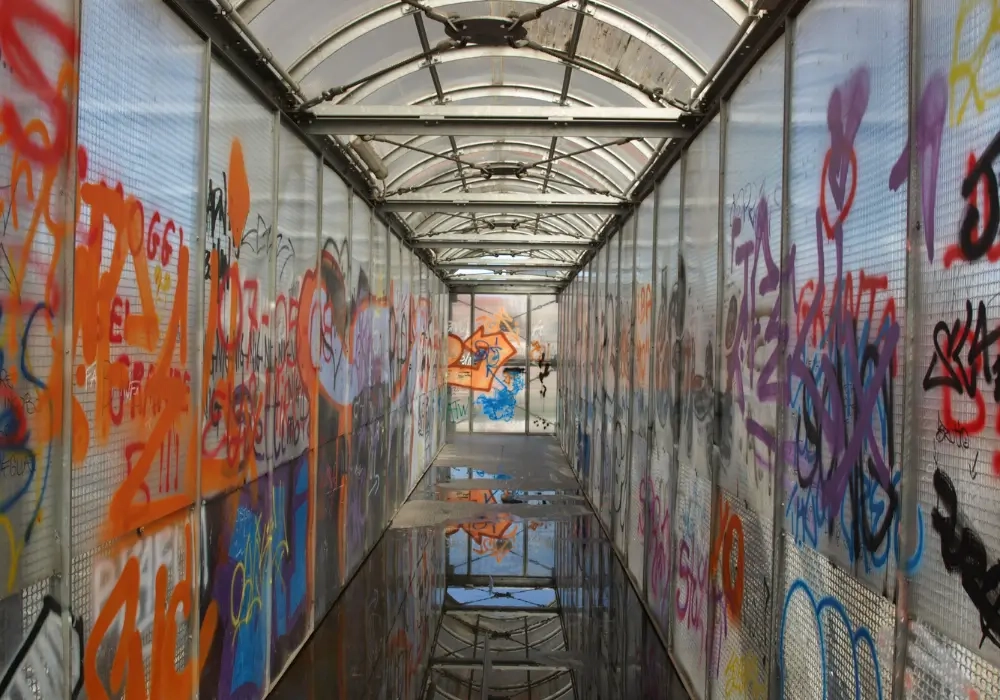With 1 million ASB incidents recorded by the police in the year ending September 2024, emphasising the large scale issue that still plagues many Councils and Local Authorities.
ASB deterrence plays a key role in reducing crime and minimising the impacts from this, but what security option is best for this?
We explore the differences between CCTV to security patrols, two popular measures to help prevent and reduce crimes across various industries.
What is ASB and Why Deterrence Matters
ASB stands for Anti-Social Behaviour which is defined as 'behaviour by a person which causes, or is likely to cause, harassment, alarm or distress to persons not of the same household as the person'.
Often labelled as low-level crime, public sector organisations will generally manage ASB alongside the police, however, for many the issue remains difficult to manage.
There are numerous crimes that fall under the ASB umbrella, and due to this, the best response to help reduce it is to implement deterrence tactics.
ASB deterrence is vital because it helps to prevent crime before it even happens, creates psychological barriers with potential offenders, reduces long-term costs, and supports community safety.
Deterrence is defined as an action or group of actions that discourage an action or event through instilling fear or doubt of the potential consequences of this.
This method specifically focuses on criminal prevention, which means stopping a crime from happening in the first place.
Most will agree that prevention is better than reaction, especially with ASB as these crimes normally go unreported otherwise due to their assumed low-level nature.
The severe community and business impact from ASB provides reason alone as to why deterrence matters in managing and minimising this issue.
Implementing an ASB deterrent solution helps to improve public safety, boost the economy and create a community-friendly environment for all to live and visit in.
What ASB Deterrence Solutions are Available?
There are several deterrence solutions, from body worn cameras and alarm systems to motion-sensored lighting and enforcing legal measures, however, different deterrent measures support different needs.
Two popular ASB deterrence solutions include CCTV systems and security patrols. This is due to their bold presence which helps to effectively deter crime and improve public safety.
Below, we explore these two ASB deterrence solutions in more detail:
Security Patrols
Security patrols can be used in various settings to help deter ASB. From construction sites and public spaces to retail parks, office complexes and housing estates, having a human presence can make a big difference.
Security patrols tend to follow a designated route, assessing threats within the area and visibly imparting their presence to deter any potential offenders looking to engage in ASB.
Previous funding has shown success, with a trial in 2022 across 10 pilot areas leading to over 250 arrests, over 600 stop and searches and around 1,000 other enforcement actions.
In most instances, uniformed patrols have shown to reduce incident numbers in the pilot areas where they were deployed, displaying their effectiveness as ASB deterrent solutions.
CCTV Systems
As CCTV systems have transitioned from static to mobile solutions, most units are now able to fulfill the needs of more businesses and organisations, especially for those looking to manage their public spaces.
Their portability allows them to be easily relocated to various ASB hotspots and through this, has become a popular measure for deterring such crime.
Past studies have shown to decrease crime by 13% across a range of settings when CCTV is in place compared to those without.
Since then, technology has developed further, and CCTV has shown even greater success at ASB deterrence, particularly when supporting Local Authorities and Councils.

Comparing CCTV to Security Patrols for ASB Deterrence
Both popular choices, CCTV and security patrols offer two differing options in tackling crime and ensuring ASB deterrence, but how do you establish which security measure is best for you?
There are key elements relating to security that most industries will be focused on; cost, coverage and response speed.
These three areas play a large role in whether that security option is accessible for your business and its needs, but also if it can effectively deter ASB.
To help you in establishing this, we have compared CCTV to security patrols to gauge their differences across those three areas:
Cost Comparisons: CCTV vs Security Patrols
Cost is key for many businesses and organisations, however, this is particularly important to the public sector industry.
Often the first line of defence with ASB, public sector organisations like the Police, Housing Associations and Councils have tight budgets and generally require funding to commit to additional support.
During the public sector tending process, they’ll be asked to display costs and potential ROI from deploying such measures. These costs will need to stay within the boundaries of the funding.
For other businesses, budgets can still remain tight and cost can be the deciding factor as to whether to invest in one solution over another.
It’s always important to keep your business needs at the front of your mind at all times over cost. However, we understand that with the economy and strict budgets, cost-effectiveness is crucial in your decision-making process.
Below outlines the key cost expectations related to both CCTV and security patrols with ASB deterrence, to provide you with an outline on value for money:
| Cost Considerations | CCTV Systems | Security Patrols |
|
Upfront Costs |
Moderate to high upfront costs, depending on whether you purchase or rent the equipment. |
Low to no costs until the service begins, unless you utilise an agency. |
|
Recurring Costs |
Low to moderate costs, depending on the service provided. Generally, managed services will encompass maintenance and ongoing support. |
High costs due to increased minimum wage, potential travel costs, training and protective gear required for staff. Security patrol labour is known as an expensive option. |
|
Additional Value |
Additional remote audio prevention to deter ASB, without the need for police. Captures evidence for criminal proceedings and enforcement action. Provides 24/7 coverage without the need for security patrols. |
Provides the opportunity for witness statements to support any criminal proceedings. |
|
Limitations |
N/A - Their mobile design allows them to remain agile, therefore, preventing limitations. |
Security patrols will follow routes on a periodic basis in most cases, so cannot guarantee 24/7 coverage of all areas. Delays in response if not present, causing costs to be incurred or crimes being missed. |
Security Coverage: CCTV vs Security Patrols
When tackling ASB, there are many complexities involved in this due to the vast areas in which can be impacted by such crime and the numerous crime types covered under its umbrella.
This makes coverage crucial for such an issue as you need to ensure clear monitoring of a specified location or locations, whilst aiming to maintain high-quality recording of this at the same time.
ASB is not a static crime and when thinking about your coverage, you should always keep in mind the need for flexibility to manage any new or emerging threats in a different location you’re responsible for.
CCTV and security patrols work in different ways with their coverage, and below details these differences:
|
Coverage Dimension |
CCTV |
Security Patrols |
|
Operational Coverage |
Often provides 24/7, live monitoring of the specified location. |
Follow scheduled patrols which offer intermittent coverage of the specified location. |
|
Detection Range |
Depending on the manufacturer, detection range can vary from 40 metres to 100 metres. With PTZ and IR technology enhancing this further. Some cameras can provide a 150 metre view in complete darkness. |
No exact detection range, but limited to the human eye and only effective if captured during patrol. |
|
Blind Spot Management |
Advanced systems provide zoom-in capabilities and near-360 coverage to ensure no blind spots are left uncovered. |
High risk of missed blind spot coverage when security patrols are not present. Only effective when at that location. |
|
Evidence Capture |
Provides continuous recording of events, ensuring high-quality video to support criminal proceedings. |
Limited evidence as it depends on whether a security guard is present at the time. Only witness statements available with security patrols. |
|
Multi-Location Coverage |
Cameras can provide simultaneous coverage of several areas at the specified location. Mobile systems are relocatable also, so can be used to cover various locations when needs change. |
Patrols often follow scheduled routes at set time intervals and cannot monitor multiple locations simultaneously. |
|
Remote Intervention Coverage |
Advanced systems are often backed by remote monitoring services where trained professionals can intervene remotely. This includes contacting the police to the scene. |
Any crime intervention can only be provided in person when the security guard is present on the scene. |
Response Speed: CCTV vs Security Patrols
Effective ASB deterrence and prevention relies heavily on a quick, efficient response time to help de-escalate any suspicious behaviour or crime immediately.
Slower or delayed responses provide offenders with the opportunity to engage in crime and lead your business or organisation to absorb any costs related to this. For example, if they graffiti your building, you will need to pay to cover this up following the event.
It also plays a large role in maintaining public safety as for those towns worst affected by ASB, communities can be placed in fear or danger following any crime.
By deterring crime in that instant, you’re both preventing the impacts of ASB and displaying commitment to the community and any visitors within the area that you’ll keep them protected.
Below talks through the response speed elements of both CCTV and security patrols with ASB deterrence:
|
Response Element |
CCTV |
Security Patrols |
|
Incident Detection Time |
Immediate detection through live monitoring technology and remote backing. Provides high criminal deterrence through quick recognition. |
Quick to immediate if the patrol is present, however, it will be delayed if they are not present or have passed that location already. |
|
Initial Deterrence Speed |
Within seconds a trained professional can activate both automated and live visual and audio deterrents to prevent crime. |
Between minutes and hours depending on the patrol schedule and dispatch time following this. |
|
Alert Escalation |
Monitoring centres that back CCTV systems can provide immediate alert escalation by calling you, the police or a guard to the scene at that moment. |
Can be delayed depending on the threat reporting system guards must follow and any control room procedures. |
|
Verification of Threat |
Provides real-time threat detection via the live camera feed and remote backing. This allows for a speedy response to help deter crime as soon as the threat is identified. |
Must be completed manually which generally takes longer as the guard must assess it in person and is limited to their view of the threat. |
|
Dispatch of Additional Resources |
Response services will typically be contacted in minutes if an active incident is recognised by the cameras. |
Security patrols may require approval to escalate or be re-routed for some reason, slowing down the escalation process. |
|
Incident Logging |
Advanced systems will offer a service that provides full incident follow-ups, detailing the incident, the response and the outcome to you. |
Security patrols will log the incident or any relevant entries following the event, therefore information may not be as accurate due to the reliance on their memory |
Choosing the Right ASB Deterrents for Your Needs
In any instance, when you’re deciding the right solution or solutions to support your business or organisation with ASB deterrence, you should consider the following 4 elements:
- Your site location
- Any ASB history at the location or surrounding area
- The main hours where risks are present
- Any other site vulnerabilities
Our guide to CCTV and security patrols with ASB deterrence should have provided you with a key insight into the strengths and drawbacks of both approaches.
You should always consider these against the above-mentioned bullet points as a hybrid approach may be suitable for you.
For example, you may choose to utilise CCTV Towers or Redeployable cameras for constant coverage of ASB hotspots and have security patrols to increase community trust across public spaces.
As the leading UK supplier of Rapid Deployment CCTV Towers and Redeployable CCTV, we have supported numerous businesses in deterring and reducing ASB.
Our solutions are designed specifically to manage complex issues such as this, without the need for additional infrastructure or support.
These units offer a cost-effective option that can save up to 88% in security costs in comparison to security patrols and guards.
Backed by a fully-managed service to ensure high-quality product maintenance, accurate threat tracking, full incident reports and expert knowledge, which cannot be covered by security patrols alone.
In most environments, our mobile CCTV solutions provide the following benefits to ASB deterrence:
- Fast response times
- Effective, efficient ASB reduction
- Crystal clear evidence capture that you can review and supply to the police
- Better ROI compared to security patrols alone
Speak with WCCTV today to assess your site and build a tailored ASB deterrent strategy that works.




